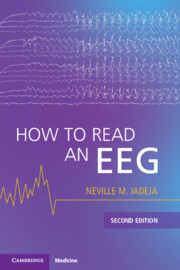Book contents
- How to Read an EEG
- Reviews
- How to Read an EEG
- Copyright page
- Dedication
- Contents
- Figure Contributions
- Foreword to the First Edition
- Preface
- How to Read This Book
- Part I Basics
- Chapter 1 Introduction
- Chapter 2 Polarity and Montages
- Chapter 3 Localization
- Chapter 4 Frequency and Rhythm
- Chapter 5 Maturation
- Chapter 6 Normal Adult EEG
- Part II Interpretation
- Part III Specific Conditions
- Appendix: How to Write a Report
- Index
- References
Chapter 6 - Normal Adult EEG
from Part I - Basics
Published online by Cambridge University Press: 27 September 2025
- How to Read an EEG
- Reviews
- How to Read an EEG
- Copyright page
- Dedication
- Contents
- Figure Contributions
- Foreword to the First Edition
- Preface
- How to Read This Book
- Part I Basics
- Chapter 1 Introduction
- Chapter 2 Polarity and Montages
- Chapter 3 Localization
- Chapter 4 Frequency and Rhythm
- Chapter 5 Maturation
- Chapter 6 Normal Adult EEG
- Part II Interpretation
- Part III Specific Conditions
- Appendix: How to Write a Report
- Index
- References
Summary
This chapter focuses on recognizing the features of a normal adult EEG during wakefulness, drowsiness, and various stages of sleep. The EEG normally remains consistent during adult life and should be interpreted in the context of physiological state. Normal wakefulness is characterized by a reactive posterior dominant alpha rhythm, anterior faster beta activity, eye blinks, and muscle artifact. Drowsiness is characterized by attenuation of the posterior dominant rhythm, diffuse slowing into theta range, emergence of slow lateral eye movements, and dissipation of muscle artifact. Vertex waves and positive occipital sharp transients of sleep (POSTS) occur during stage N1 sleep, and stage N2 sleep is characterized by K complexes and sleep spindles. Diffuse high amplitude semirhythmic delta slowing is present in stage N3 sleep and saw tooth waves occur in rapid eye movement (REM) sleep. [134 words/763 characters]
Information
- Type
- Chapter
- Information
- How to Read an EEG , pp. 57 - 68Publisher: Cambridge University PressPrint publication year: 2025
References
Accessibility standard: WCAG 2.2 AAA
Why this information is here
This section outlines the accessibility features of this content - including support for screen readers, full keyboard navigation and high-contrast display options. This may not be relevant for you.Accessibility Information
Content Navigation
Allows you to navigate directly to chapters, sections, or non‐text items through a linked table of contents, reducing the need for extensive scrolling.
Provides an interactive index, letting you go straight to where a term or subject appears in the text without manual searching.
Reading Order & Textual Equivalents
You will encounter all content (including footnotes, captions, etc.) in a clear, sequential flow, making it easier to follow with assistive tools like screen readers.
You get concise descriptions (for images, charts, or media clips), ensuring you do not miss crucial information when visual or audio elements are not accessible.
You get more than just short alt text: you have comprehensive text equivalents, transcripts, captions, or audio descriptions for substantial non‐text content, which is especially helpful for complex visuals or multimedia.
Visual Accessibility
You will still understand key ideas or prompts without relying solely on colour, which is especially helpful if you have colour vision deficiencies.
You benefit from high‐contrast text, which improves legibility if you have low vision or if you are reading in less‐than‐ideal lighting conditions.
